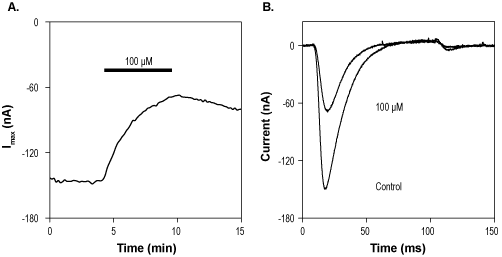Overview
- Singh, A. et al. (2010) Brit. J. Pharmacol. 160, 1464.
 Alomone’s Labs SKF 96365 hydrochloride inhibits T-type CaV channels expressed in Xenopus oocytes.A. Time course of CaV3.1 peak current amplitude, elicited by 100 ms voltage step from holding potential of -100 mV to -20 mV, delivered every 10 seconds. Application of 100 µM SKF 96365 hydrochloride (#S-175) inhibits the CaV3.1 current in a reversible manner (indicated by the horizontal bar). B. Representative current traces before and during application of 100 µM SKF 96365 hydrochloride as indicated.
Alomone’s Labs SKF 96365 hydrochloride inhibits T-type CaV channels expressed in Xenopus oocytes.A. Time course of CaV3.1 peak current amplitude, elicited by 100 ms voltage step from holding potential of -100 mV to -20 mV, delivered every 10 seconds. Application of 100 µM SKF 96365 hydrochloride (#S-175) inhibits the CaV3.1 current in a reversible manner (indicated by the horizontal bar). B. Representative current traces before and during application of 100 µM SKF 96365 hydrochloride as indicated.
SKF 96365 hydrochloride is a synthetic blocker of CaV3 (T-type) voltage gated calcium channels and of TRPC channels. In addition, it has a blocking effect on potassium channels. SKF also inhibits the calcium sensor STIM1 which enables Store-operated Ca2+ entry (SOCE). SKF has an effective concentration of 1-100 µM and an IC50 of 560 nM for CaV3.1 channel. SKF is used to identify CaV3 and TRPC channels in many cell types. In an experiment examining the effect of SKF on CaV3 conductivity, perfusion of 1 µM of SKF reversibly inhibited 86.3±0.1% of CaV3.1 currents generated in HEK293 cells. Maximum inhibition was reached within 6-7 minutes. Application of larger concentrations of SKF completely abolished CaV3.1 channel currents. SKF blocks the CaV3.1 channel in a tonic manner indicating it interacts with the channel regardless of its functional state, unlike other CaV channel blockers. In the same experiment SKF also abolished calcium currents in other types of CaV channels such as P/Q-type and N-type.
Blockade of these channels was only partially reversible due to possible irreversible binding of or longer washing time required. In addition, SKF blocks L-type calcium channels but in a much slower manner than other calcium channels.

